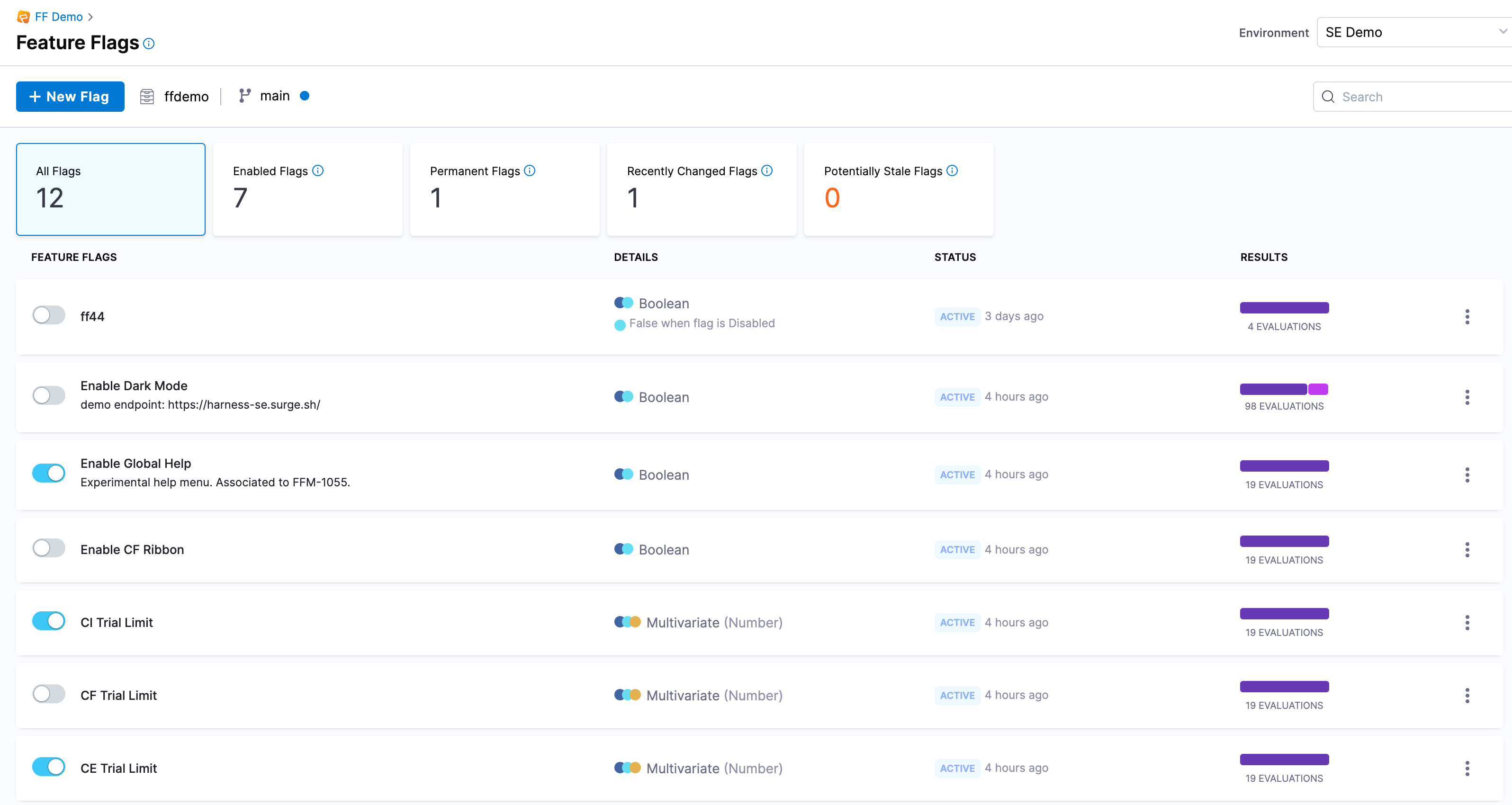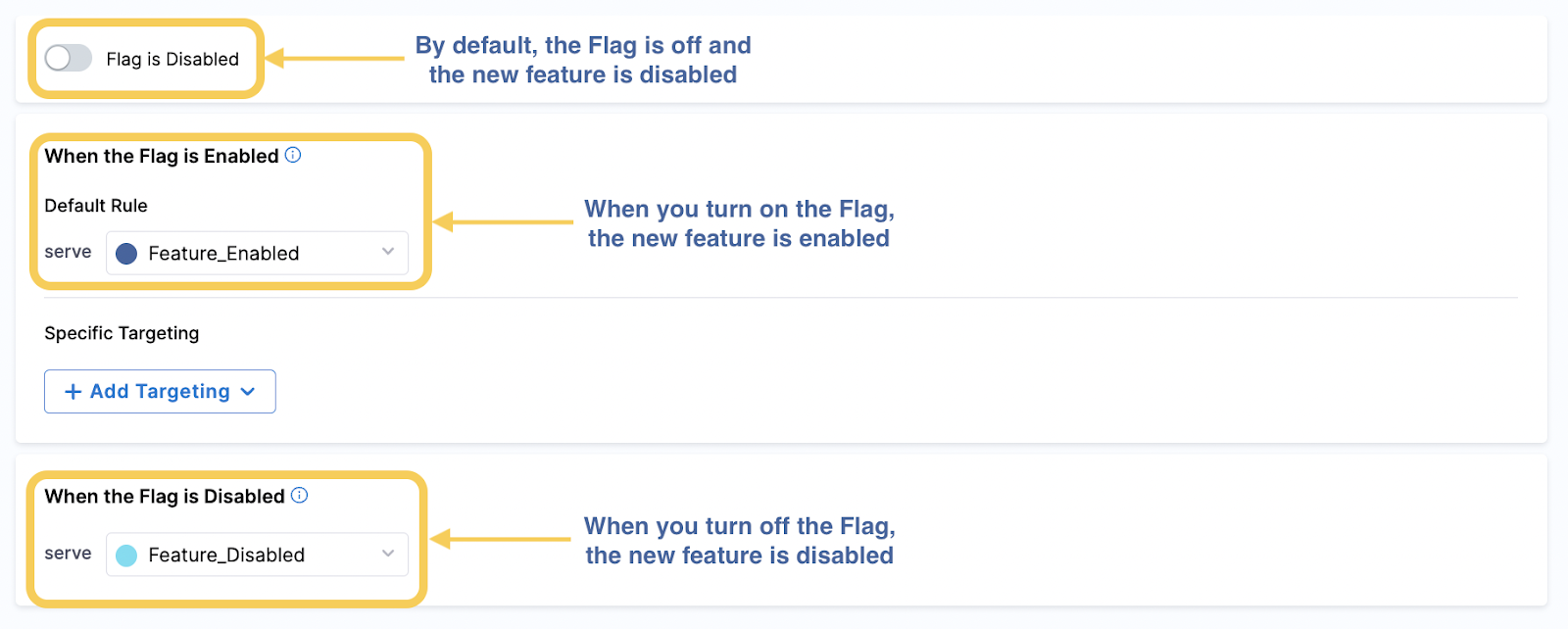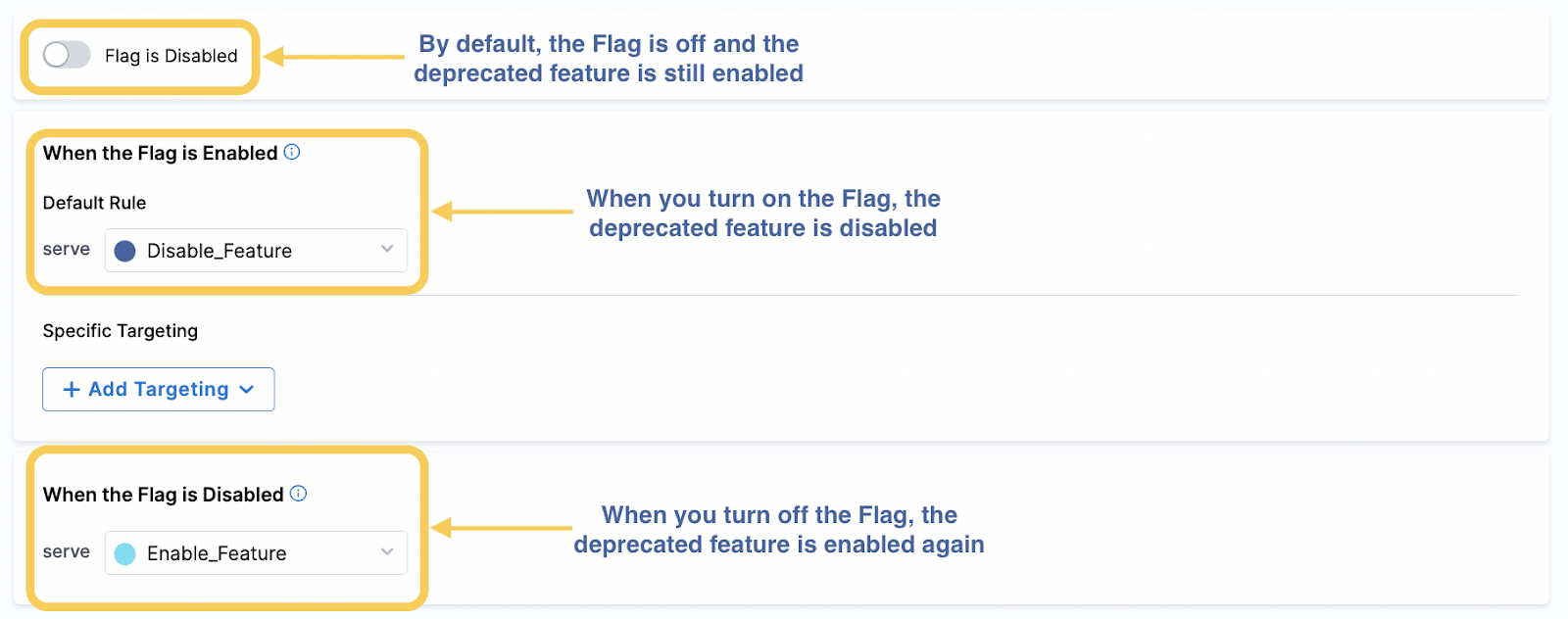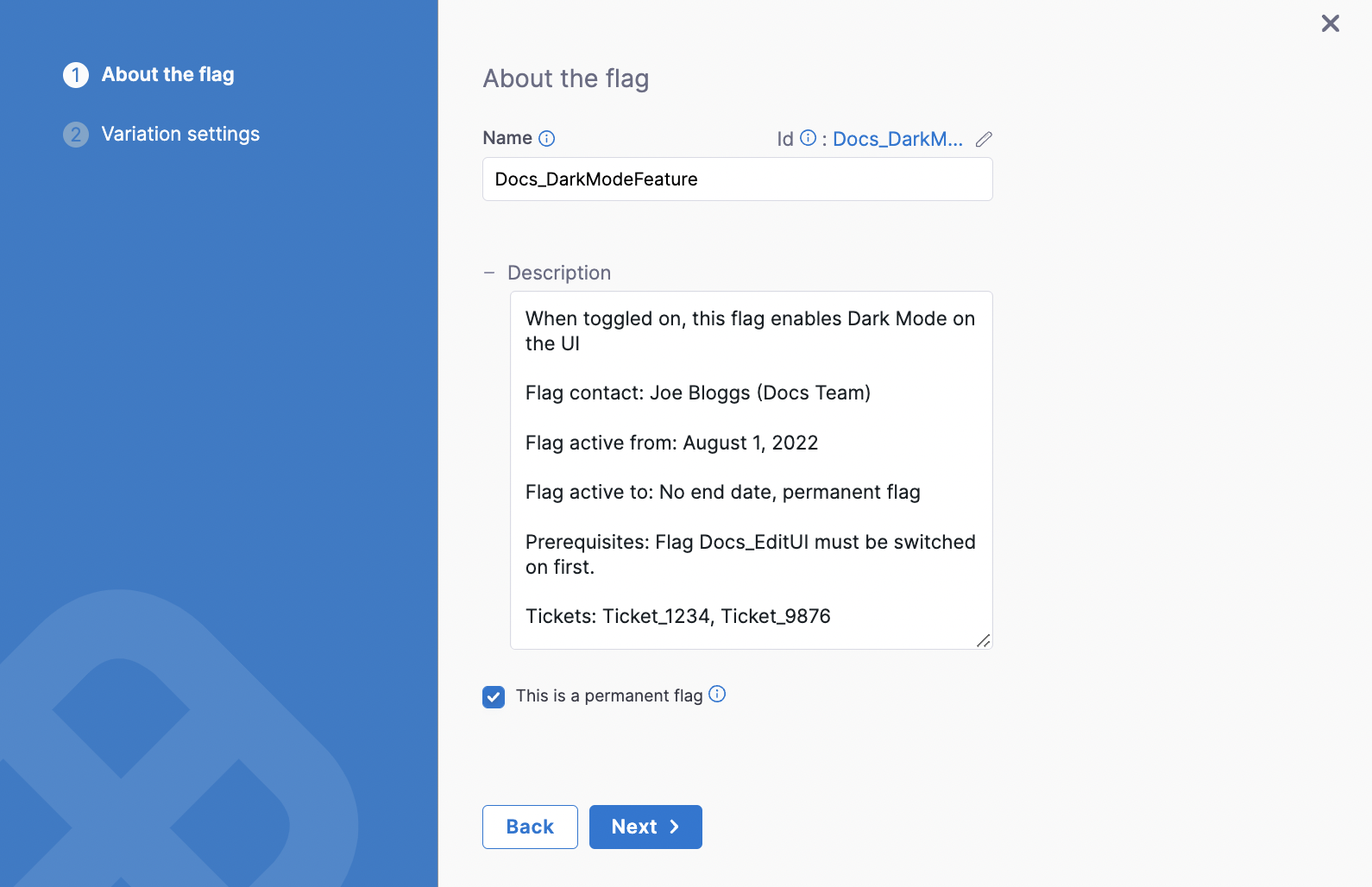Best practices for managing flags
As teams adopt Harness Feature Flags, or consider adopting the practice of feature flagging, they often wonder what problems they should consider early on to set them up for success.
To help you get the most out of your feature flags, we've drawn up some best practices that you can implement to manage them. The points below aren't mandatory but they can help you organize your flags and plan for the future so you don't have to revise them at a later date.
Following these best practices can help your software teams use feature flagging to get more control, whether you're implementing feature toggling, trying to expand your feature testing, hoping to control system behavior to control access, or rolling a feature out to your entire user base.
Use flags for every change
"Feature flagging sounds great, but how do we get started?"
This is a question we get all the time, and it makes sense. But our answer is always the same: Any code change you're making, put it behind a feature flag!
Instead of waiting for a specific use case where you know exactly how you want to use flags for a given feature or exactly what want to control, think of feature flags like a Continuous Delivery pipeline in the sense that if you're making a change, it should go through CD. Likewise, if you're making a change, you should put it behind a flag.
Feature flags should be a core part of your testing process going forward, and the more of your changes are behind flags, the more optionality you will have in the future. If a change causes a system outage, you can turn it off if it's behind a flag - even if you never anticipated that use case ahead of time.
Similarly, being able to test a change in any given environment and collect data could always be useful, even if you're not planning on it right now. Because many feature flags encompass discrete functionality, even in cases of multiple feature toggle configurations you can easily turn off combinations of feature flags.

Plan your Feature Flags
Before you even create a Feature Flag, it's best practice to create a plan for it. While planning, there are a number of things to consider:
Flag use cases
Decide on what the flag will be used for and how it will be used by your team, remember to think about the following:
- The purpose of the flag, for example, if it will be used for a feature release, experiment, or to give particular users certain permissions.
- Who the flag will be toggled on and off for.
- When the flag will be toggled on and off.
- Which environments you'll use the flag in.
- Whether the flag will be temporary or permanent. For example, if you're testing a new feature, you might create a temporary flag that you can later delete after the feature has been successfully released. A permanent flag could be used for daily operations such as ensuring only users with certain roles have access to features.
- If the flag will impact any other flags you have already created, or if any other flags will impact the new flag you're creating.
- Whether you need a simple Boolean flag, or a Multivariate flag. If there is a chance your flag will need to have more than two variations in the future, it's best to create a Multivariate flag to give yourself the flexibility to add more variations later.
Default flag variation
The variations of your flags determine what will be served to your users. When deciding the default flag variation, consider what is an intuitive variation for what you're using the flag for. For example:
-
If you are using a flag to release a feature, you create a Feature Enabled and Feature Disabled variation. Feature Disabled = False and Feature Enabled = True. The variation that you assign to False is always the default until you change it, so it is easy to understand that when Feature Enabled is toggled on, the feature is then switched on, for example:

-
However, if you are deprecating a feature, the opposite makes sense. The default False variation is called Feature Enabled and Feature Disabled = True. Therefore, when you toggled the flag on, the feature is switched off, for example:

Flag dependencies
Determine if the flag needs prerequisite flags and be prepared to add them. For example, if you have a flag for front-end changes that depends on back-end changes being implemented first, you can add a prerequisite that the back-end flag must be turned on before the front-end flag is turned on.
Rollout rules
Create a set of rules with your team to ensure your rollouts run smoothly. There are a number of Harness Features you can utilize to help with this, such as using approval steps in pipelines or using the Harness Policy Engine. When creating roll-out rules, it's important to consider:
- Types of roll outs you may run, and the strategy for each.
- Rules that must be applied for all roll outs, for example, a rule stating that a flag cannot be switched on in your production environment until it has been tested in your QA environment for one week.
Name your flags well
It is likely that you'll use many flags and it's important to keep them organized and easy to understand what they are used for. One of the easiest ways to stay on top of them is to implement a naming convention that you follow for all flags. When creating a naming convention, consider:
- Flag names should be unique. Although on the Harness Platform, only unique identifiers are enforced, it's good practice to keep your flag names unique too so your team don't confuse them.
- Make the names user friendly; they should describe what the flag does. For example, EnableVersion2UI describes that the flag enables Version 2 of the user interface.
- If your flags are specific to a team, consider adding the team to the flag name, for example,
Dev_EnableVersion2UI. - To help with keeping your naming consistent, you could use the Harness Policy Engine to enforce it.
- Don't forget to tell your whole team what the naming convention is, so that anyone who creates a flag uses the correct convention.
Give flags human-readable names
Feature flags bring many advantages, but often teams don't think of how they want to manage feature flags until they are further along and have many old flags, some sitting on top of stable code that is no longer being toggled. This leads to production becoming incredibly untidy as organizations scale, and erodes the value of using a feature flag system. If the idea of feature flags is to speed up development and reduce risk, doesn't bloating the system run counter to that?
Even in scenarios where teams know what they want to clean up, they often find that they can have trouble knowing what a particular feature flag does. This is because oftentimes, the names are engineering-focused (something like NEXT_OLD_GEO3). We recommend giving feature flags human-readable names to help make feature flag management easier over time. While this won't solve the potential problem of bloat all by itself, having easy-to-locate feature flags is a step forward in making timely cleanup or lifecycle management possible.
As one example, if flags are for user-facing new features, give flags a name that less technical users from the company would identify with the feature. Remember, it won't always be engineers working with feature flags. In the example above, let's say that NEXT_OLD_GEO3 refers to a region-bound target group on a feature flag, and that flipping the flag will turn on a set of feature flags for users in Europe. Teams are working towards a new set of privacy or GDPR-compliant features, and they want to test them with real production data for the European user base.
However, over time, you'll want to phase out this flag as the features become permanent in production. This one flag alone might flip fifty others all on its own! You can imagine how it would be hard to find this flag to flip the features on, and then to clean it up. Here, it might make more sense to call the flag Privacy_Features_Europe.
Your end goal is to make individual feature flags easier to find, espcially for non-engineering users. With Harness, you can even enforce naming conventions with the use of global governance policies for feature flags.
Add descriptions to your flags
Add a description to your flag. This is optional on the Harness Platform, but we highly recommend it as it can provide much more information than the flag name alone. The description should be short but include relevant details, for example, you could include:
- The contact information for who is responsible for that flag.
- How long the flag should be active for.
- Any prerequisite flags that need to be toggled on before you use this flag.
- Links to information or tickets related to the flag.

To help with this, you can use the Harness Policy Engine to enforce descriptions when creating a flag.

Manage targeting with target groups
When using Feature Flags, you select targets to serve a particular variation of the flag to, for example, serving True to enable a feature for some users and False to disable the feature for others. We often refer to targets as users, but a target can be anything that can be uniquely identified such as a user, an application, a machine, or any resource uniquely identified by an IP address, email ID, user ID, etc.
As you're likely to have many targets, we recommend that you organize them by creating target groups and adding the relevant targets to them, so you can add the group rather than each individual target when serving a flag variation. You can add targets to a group based on conditions you set instead too, instead of adding each one individually.
One flag does not rule them all
Let's say we're rolling out a new feature to all of our premium users, and this feature requires both a frontend and a backend change. This is common. Most of your user-facing features will have multiple associated changes. It can seem like it makes sense to put all of these changes behind a single toggle.
In practice, though, it is better to have a smaller toggle scope, with smaller feature flags linked together. When everything is behind one flag, it can be hard to know which code paths specifically caused a problem. Additionally, it can be difficult to test more discrete changes along the way as you iterate on the feature.
Delete old flags
Remember to delete flags after you have finished with them to keep your code clean and organized. For example, you could do a flag clean-up sprint at the end of each quarter, or add a flag clean-up story to each epic to ensure you are removing out-of-date flags.
Avoid tech debt hell
Another feature flag management oversight that many teams make is not having a clear internal process or agreement around who owns removing stale flags. Or how often they want that process to happen. This can often lead to teams feeling there are too many feature flags or that they're stuck in feature flag hell. That's not where you want to be if you want to reap the benefits and continue to create more feature flags, especially in a production environment.
One of the benefits of flagging is allowing teams all across the company to use flags for a wide variety of different scenarios such as experiment toggles to test user behavior, ops toggles, or using backend flags to modify system behavior.
The downside is, with many new features and anyone having access to implement feature flags, you will find that your application code can have feature flags all over the place. In addition to having feature flags spread across the code base, the feature flag management system will also grow as each one of these new feature flags is established in the code. In other words, as use of feature flags grows within the organization, these are two places where hygiene needs to be maintained.
We don't believe there is any such thing as too many feature flags, but you want to make sure that you are removing stale, unnecessary, or out-of-date feature flags as you launch new flags for each new feature. This will make it a lot simpler to avoid the downsides that come with bloated feature flag systems and keep reaping the benefits.
Have conversations up front. How often will you remove stale flags? Who is responsible? Are there different owners for different types of flags? Which are permanent feature flags that should never be removed? It's worth knowing that Harness even brings to your attention the number of stale flags in your system
Some of the largest enterprises, such as Facebook, Pinterest, and Netflix, regularly make use of feature flags to collect data and deliver the best experience for their user base. These organizations have thousands of flags, and it's imperative that hygiene is appropriately handled to ensure operability at scale.
The thing is, feature flag hell can tend to creep up on teams as they blaze through their backlogs and start to speed up their software delivery processes. While it's important to think about how flags will be managed once at scale, it pays dividends to plan for this in advance.
Create enforceable governance processes
One way to avoid feature flag hell is to have good governance processes. What we mean by governance is essentially creating scalable processes to ensure procedures and best practices are followed and enforced.
These governance steps can include things such as going through a set of approvals, only committing to releases when certain triggers are met, or verifying against performance metrics. The point here is that before a feature is released (not deployed, but released) it needs to go through some checks and balances to ensure that things are being done the right way to avoid issues in the first place.
The other side of this is that issues do occur, so what do you do about them? As part of the governance process, it's important to ensure that teams are able to properly audit the goings-on. Especially for something like feature flags, which breaks out each individual change into its own control point, it's critical to be able to understand what's going on and what has gone on while triaging the issue. Ensuring that audit logs are readily available is one part of the puzzle, but having a solid governance process whose steps, as taken, end up in the audit log, is probably the bigger piece of the puzzle.
Obviously, it would be really nice if this could be automated in any way. You might realize that you have a consistent set of steps and only a few variations over time, so it's worth thinking through, too, how you can templatize and eventually automate the process.

Consider trunk-based development
Trunk-based development with feature flags will help your teams move faster and pull complexity and risk out of your code deployment and feature release process. By having fewer long-lived branches and code paths, and more feature flags keeping changes dark even in your production environment, you will be able to merge more, deploy more, and ultimately reduce risk substantially.
Remember your environment
As flags can have different states in different environments, when using them, make sure you remember to switch the flag on or off in the correct environment.
Think about operational toggles (not just release toggles)
Given that it's right there in the name, feature flags are most often implemented as a way to do a release toggle, or an experiment toggle. But, there are different toggles that you may find useful! Critically, feature flagging to create operational toggles (or ops toggles) is a great, underutilized way to use feature flags.
Putting flags around certain code paths that control key configuration settings, rather than around features, leaves you prepared to respond instantly to any type of production failure, bringing your mean time to resolution (MTTR) down, and reducing the difficulty in responding to stressful system outages.
Leverage feature flags as the first line of defense
Feature flags move the lowest layer of control to the feature level, or the release level. By separating deployment from release, engineering teams are able to empower other teams to engage with feature flags for their own purposes, such as product management, sales, marketing, or customer support.
The first thing that this allows is for better incident management, or what might be referred to as mean time to resolution (MTTR). In the case of an issue, anyone with access to the appropriate feature flag can simply toggle the flag off for the affected users or targets. Instead of having to wait for a formal escalation response from engineering, the feature can be toggled off to minimize the blast radius while engineering figures out the problem without the looming pressure of customer impact.
You might have caught a second benefit in there: resolving issues without initiating a rollback or roll forward procedure. Imagine a scenario where a single deployment has dozens or hundreds of changes, and because of individual errors, having to roll back the entire deployment - including all of the good features. This adds immense stress and pressure to the deployment phase of the software delivery process. In a feature flags world, there are no rollbacks - just turn it off.
In turn, this begins to alleviate the problem of deployments becoming bigger over time, which inherently are slower and more risky to deploy. Teams have to spend longer verifying every detail to ensure that no incidents occur and no war rooms or rollbacks have to be initiated. By moving this pressure to the feature level, deployments can suddenly start to be smaller, backed by the promise of changes wrapped behind flags, adding a second layer of defense.
Test in production with live data
Testing in production is not quite what it sounds like. While we do not advocate that features should be pushed to production without going through the proper CI/CD process, we do believe that teams should be testing features in real-world situations instead of just on test data.
Teams can put feature flags in production that are ready for a live run, and collect data to understand how well it's behaving. Is it causing issues? Is it solving the customer's problem? Is it driving the right metrics? Based on this data, teams are able to iterate faster on their changes or other features, and to deliver higher-quality end results.
Another application of this is trying out multiple solutions with real customers. Instead of having to make the risky decision behind closed doors and hoping for the best, teams are enabled to put multiple MVPs into production to see what best meets the customer's needs. In the end, customers get more of what they want, and internal teams reduce their stress and risk factor. It's a win-win.
It's important to remember here that in order to test in production effectively, you need to ensure that you're able to capture the evaluation data from the test and apply that to the appropriate context. If you're putting feature flags out there and you're not able to collect data, how will you do the analysis that testing in production enables?
This can be difficult to build, and even more so to map that data to the appropriate business context, such as impact on revenue, reduction in downtime, or customer satisfaction. You'll want to make sure that you can capture evaluation data and apply it in the way that's needed.
Try Harness Feature Flags today
Feature flagging can and will speed up your team, reduce the volume and severity of incidents, and make it easier than ever before to be reactive to your customers and to be a learning-focused organization.
By implementing the right tools, practices, and processes at your organization, you'll find that you're able to go the full mile with feature flags and really ensure that you're getting the most value out of them. Hopefully, with these feature flags best practices you will see smooth sailing and find more ways to use flags.
If you're looking for a way to implement these best practices and ensure that you have a solution that supports your ability to do so, and even have some best practices baked in, it's well worth your time to check out Harness Feature Flags. Sign up for a demo or a free trial today.